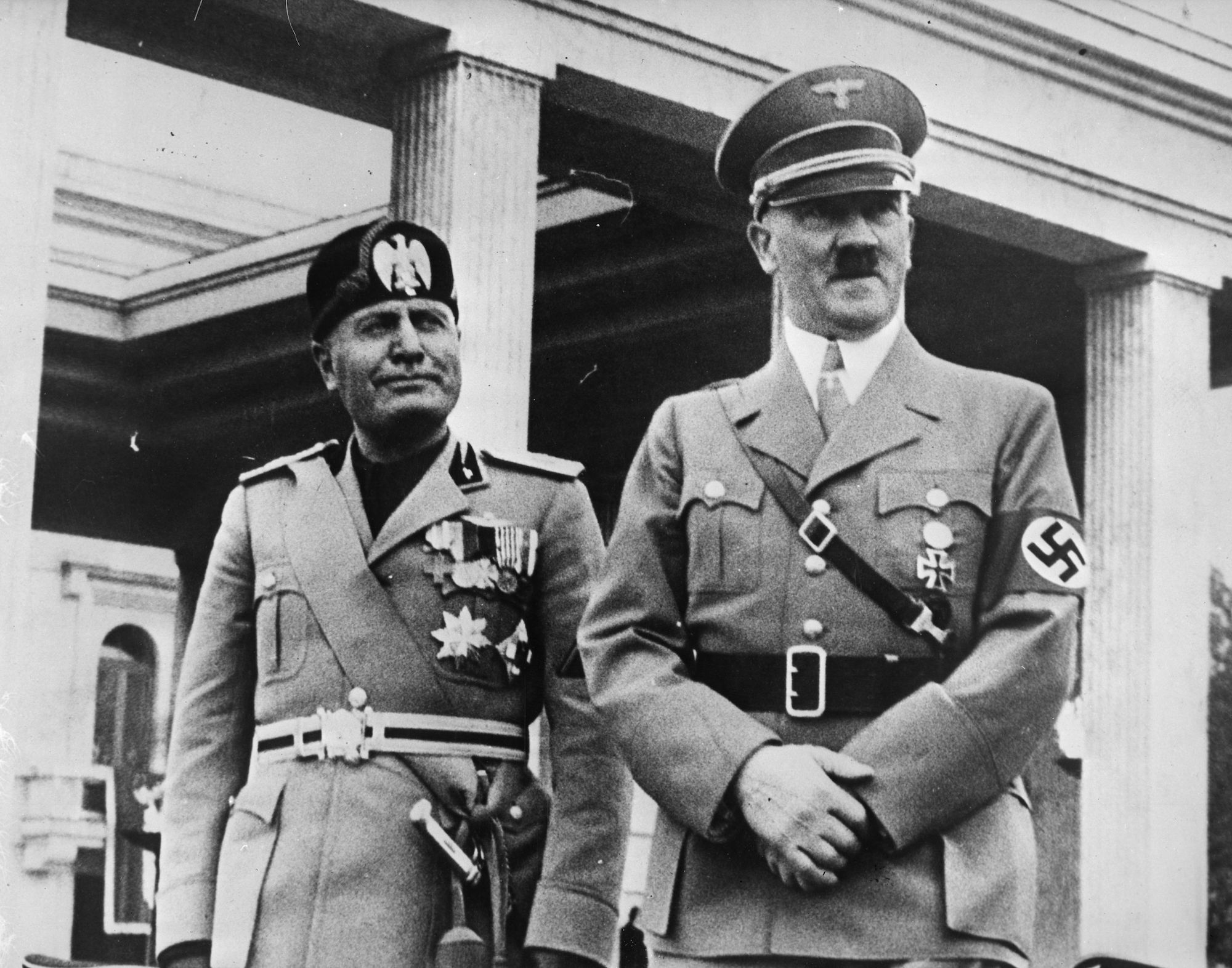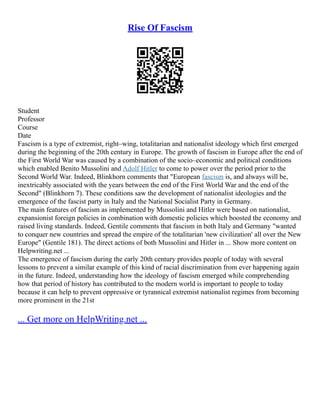Once upon a time, in a world not so far away, two sinister ideologies reared their ugly heads and shook the very foundations of humanity. In one corner, we have Fascism – the mustachioed villain from Italy, charming with his promises of national pride and supremacy. And in the other corner, we have Nazism – the jackbooted brute from Germany, with his goose-stepping minions and love of genocide. Join us as we embark on a historical comparison of these two dastardly forces, analyzing their rise to power, their tactics of control, and their eventual downfall. So grab your history books and your smelling salts, dear reader, as we delve into the dark and twisted world of Fascism and Nazism. Let the analysis begin!
Key Characteristics of Fascism and Nazism
Fascism and Nazism share many key characteristics that set them apart from other political ideologies. Here are some of the standout features:
- Authoritarian Leadership: Both fascism and Nazism emphasize a strong leader who holds absolute power and control over the government and its people. Think of it as a one-man show, with no room for dissent or opposition.
- Nationalism: These ideologies are all about putting your country first, no matter the cost. It’s like rooting for your sports team, except the stakes are much, much higher.
- Militarism: Guns, tanks, and uniforms – oh my! Both fascism and Nazism glorify the military and believe in using force to achieve their goals. It’s like a never-ending game of Capture the Flag, except with real consequences.
So, if you ever find yourself at a party and someone starts talking about the virtues of authoritarian leadership, extreme nationalism, and militarism, it might be time to make a swift exit. Just remember: fascism and Nazism may have catchy slogans and snazzy uniforms, but the consequences of their ideologies are no laughing matter.

Origins and Ideologies of Fascism and Nazism
Fascism and Nazism are two ideologies that have their roots in the early 20th century, but have vastly different origins.
While Fascism originated in Italy under the leadership of Benito Mussolini, Nazism found its beginnings in Germany with Adolf Hitler at the helm. Despite their differing birthplaces, both ideologies share some common characteristics, such as extreme nationalistic beliefs and a disdain for democracy.
One of the key ideologies of both Fascism and Nazism is the belief in the superiority of one’s own race. This manifested in horrific ways during World War II, with the Nazi regime carrying out the systematic genocide of millions of Jewish people in the Holocaust.
Overall, both Fascism and Nazism are ideologies rooted in hatred, fear, and a thirst for power. They serve as a grim reminder of the dangers of allowing such ideologies to take hold in society.

Rise to Power of Fascist and Nazi Regimes
Fascism and Nazism were never the cool kids in high school, but somehow they managed to rise to power and become the mean girls of Europe in the 1930s. Here’s how these unpopular cliques managed to bully their way to the top:
First, they used some sneaky tactics to gain followers. They promised to make their country great again (sound familiar?) and blamed all their problems on someone else – immigrants, minorities, and anyone who looked different. This fear-mongering peaked the interest of those looking for a scapegoat for their troubles.
Next, they started their own little fan clubs, complete with snazzy uniforms and secret handshakes. By creating a sense of camaraderie and exclusivity, they made their followers feel like they were part of something special (even if that something was pretty awful).
Finally, they used propaganda like it was going out of style. From catchy slogans to fiery speeches, they bombarded their citizens with messages of hate and intolerance. They even control the media to ensure their version of the truth was the only one that mattered. Talk about fake news!

Policies and Practices under Fascism and Nazism
Under the regimes of Fascism and Nazism, policies and practices were implemented that were quite, let’s say, questionable. Some of these included:
- Suppression of dissent: Who needs free speech anyway? Criticizing the government was a big no-no under these dictatorships. Freedom of expression? More like freedom to shut up.
- Racial purity laws: Ah yes, because nothing says progress like deciding who is allowed to exist based on their genetics. Forget meritocracy, let’s judge people based on something they have zero control over.
- Military expansionism: Because why focus on building a strong economy and improving the lives of citizens when you can just invade other countries instead? Who needs diplomacy when you have an army, right?
Overall, the were truly a sight to behold. It’s almost like they were trying to outdo each other in terms of how oppressive and destructive they could be. But hey, at least they were consistent in their commitment to being terrible, right?

Impact of Fascism and Nazism on Society
During the era of Fascism and Nazism, society underwent significant changes that left a lasting impact on the world. Here are some ways in which these ideologies shaped society:
- Suppression of Dissent: Fascist and Nazi regimes were notorious for silencing any form of opposition, whether through censorship, propaganda, or outright violence. This led to a culture of fear and paranoia where individuals were afraid to speak out against the ruling party for fear of persecution.
- Militarization: Both Fascism and Nazism glorified military strength and conquest, leading to a society that was heavily focused on war and aggression. This militaristic mindset permeated all aspects of life, from education to entertainment, creating a culture that valued violence and domination.
- Racial Purity: Perhaps the most disturbing was the promotion of racist ideology that led to the persecution and extermination of millions of people. The belief in the superiority of the Aryan race led to atrocities that are still remembered today as some of the darkest moments in human history.
Overall, the was profound and long-lasting. While these ideologies may have been defeated in the physical sense, their echoes can still be felt in the world today. It serves as a stark reminder of the dangers of extremism and the importance of standing up against oppressive regimes.
International Response to Fascism and Nazism
In the face of rising fascism and nazism, the international community has come together to condemn these dangerous ideologies with a resounding “Oh no, you didn’t!”
From passionate speeches to coordinated protests, countries around the world are uniting to say “Fascism and Nazism? More like Fass-no-ism and Nop-zi!”
- United Nations: The UN has issued a strongly worded statement decrying fascist and nazi ideals, calling them “so last century.”
- European Union: EU leaders have banded together to create anti-fascist task forces, armed with an arsenal of witty comebacks and historical facts.
- United States: In a bold move, the US has declared that fascism and nazism are ”not cool, man” and pledged to combat these ideologies with a mixture of diplomacy and sarcasm.
With a united front and a sense of humor, the is sure to leave these hateful ideologies shaking in their jackboots. Stay strong, stay sassy, and remember: fighting hate is always in style!
Legacy of Fascism and Nazism Today
Despite being defeated decades ago, the lasting impact of fascism and Nazism can still be seen in various forms today.
One of the most concerning legacies is the rise of far-right extremist groups, who continue to spread hate and intolerance under the guise of nationalism. These groups often idolize fascist leaders and ideologies, perpetuating dangerous beliefs that have no place in modern society.
Additionally, the echoes of fascism can be heard in the rhetoric of certain political leaders who promote discriminatory policies and divide communities based on race, religion, and nationality.
It is essential to remember the atrocities committed under these regimes and work towards creating a world where such hatred and oppression have no place.
FAQs
What are the key differences between fascism and Nazism?
While both ideologies share some similarities, such as authoritarianism and nationalism, the key difference lies in their objectives. Fascism aims to create a totalitarian state based on a strong, centralized government, whereas Nazism adds a racist and anti-Semitic dimension, seeking to establish a master race and eliminate perceived subhuman groups.
How did fascism and Nazism rise to power in their respective countries?
Fascism rose to power in Italy through political upheaval and social unrest, with Benito Mussolini capitalizing on discontent to become Prime Minister in 1922. Nazism, on the other hand, gained power in Germany through a combination of economic hardship, political maneuvering, and propaganda, leading to Adolf Hitler’s appointment as Chancellor in 1933.
What role did propaganda play in the spread of fascism and Nazism?
Propaganda played a crucial role in both fascist Italy and Nazi Germany, shaping public opinion, demonizing enemies, and glorifying leaders. Mussolini and Hitler both understood the power of propaganda in manipulating the masses and used it to great effect in promoting their ideologies.
How did fascism and Nazism impact society and culture in their respective countries?
Both fascism and Nazism had a profound impact on society and culture, with strict censorship, propaganda, and state control over the media stifling dissent and promoting conformity. Artists and intellectuals were often persecuted or forced to conform to the regime’s ideology, leading to a stifling of creativity and free expression.
What were the consequences of fascist and Nazi rule?
The consequences of fascist and Nazi rule were devastating, resulting in widespread human rights abuses, atrocities, and war. Fascist Italy and Nazi Germany engaged in aggressive military expansion, leading to the deaths of millions and the devastation of Europe. The Holocaust, in particular, stands as a stark reminder of the horrors of fascist and Nazi ideologies.
—
In Conclusion, Fascism and Nazism Aren’t Exactly a Barrel of Laughs
So there you have it, folks. Fascism and Nazism – not exactly a hoot and a half. Sure, they may have sparked some snazzy uniforms and catchy slogans, but at the end of the day, they’re about as fun as a bag of wet socks. So let’s all do our part to keep these ideologies where they belong – in the history books. And remember, the real key to a successful dictatorship is a killer mustache. Stay woke, friends.






